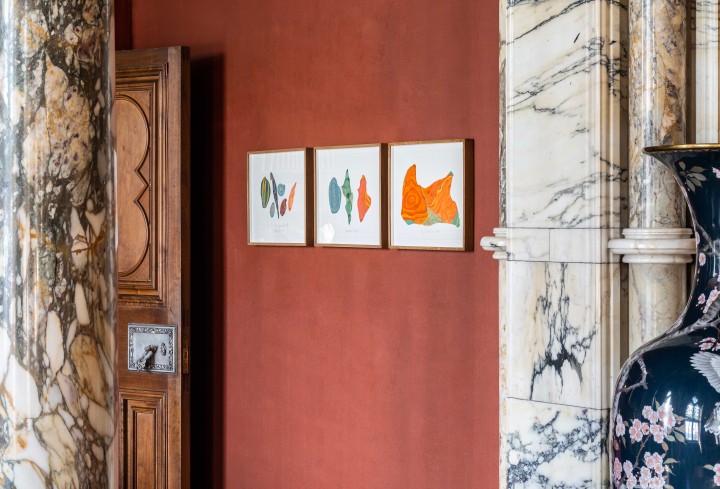Scottish Art News
Latest news
Magazine
News & Press
Publications
Living Mountain
By Greg Thomas, 07.06.2021

In the crypt of the marble chapel at Mount Stuart, an opulent Victorian-gothic mansion on the Isle of Bute, Ilana Halperin’s Stone Cycle rests on the cool terracotta like a gathering of ancient relics. A rough circular arrangement of broken tilework and bricks, the found objects shine in an odd white casing as if shod in a layer of bone, feeding off the sepulchral ambience of the space.
These are remnants from an old clay-works once located on Kilchattan Bay in the south of Bute, tossed into the Firth of Clyde when the workshop closed in 1915. Halperin, who divides her time between Bute and Glasgow, fished the broken tiles and bricks from the sea and sent them to the Fontaines Pétrifiantes de Saint-Nectaires in Auvergne, France, a family-owned cave complex whose water is so calcium-rich that it adds a thick crust of limestone to objects placed in its springs within months, speeding up a process that normally takes centuries.
.jpg) Ilana Halperin, Our Hands Enact the Geologic Process (Part One), 2020. Courtesy the artist and Patricia Fleming Gallery, Glasgow. Photograph Keith Hunter.
Ilana Halperin, Our Hands Enact the Geologic Process (Part One), 2020. Courtesy the artist and Patricia Fleming Gallery, Glasgow. Photograph Keith Hunter.
With their porous white surfaces, rubbed back in places to reveal a marrow of baked clay, the components of Stone Cycle, the last stop on my tour of Mount Stuart with curator Morven Gregor, are an exquisitely uncanny expression of Halperin’s aesthetics, much concerned with the relationship between human beings and geology, using the migratory patterns of rock and lava to tell stories about our nomadic natures. A sequence of gorgeously saturated watercolours, Field Studies, serves as an introduction to the show, arranged in a first-floor gallery off the lavish Marble Hall. Precise, colourful striations and divisions of space evoke both tectonic movements and local botany, with visual allusions to landmarks such as the Suidhe (the volcano behind the artist’s home on Bute) and the Highland Boundary Fault Line which bisects the island.
In the Family Bedroom, the Horoscope Room, and the Drawing Room, the luminous marks and motifs of Field Studies find new life as textiles, created on a jacquard loom or, in the case of Our Hands Enact the Geologic Process, part two, hand-stitched from merino wool by a social collective of Syrian women based in Istanbul. As well as referencing Halperin’s mother’s life as a fabric designer in 1970s New York, these pieces exemplify an aesthetics and ethics of far-flung collaboration, threading together stories of human and geological life in common narratives of restless global movement over centuries. Or, to put it simply, people are like rocks and rocks are like people.
.jpg) Ilana Halperin, Our Hands Enact the Geologic Process (Part One), 2020. Courtesy the artist and Patricia Fleming Gallery, Glasgow. Photograph Keith Hunter.
Ilana Halperin, Our Hands Enact the Geologic Process (Part One), 2020. Courtesy the artist and Patricia Fleming Gallery, Glasgow. Photograph Keith Hunter.
This is not an abstract metaphorical position for Halperin’s but an expression of genuine animal affection for the mineral composites with which we share the surface of the earth. To celebrate her thirtieth birthday in 2003, the artist travelled to Heimaey, an island off the south coast of Iceland, to ‘commune’ with the Eldfell volcano, pushed up from the sea in the year of her birth. Rocks to Halperin are animated and mobile like humans, containing multitudes of constituent elements just like us. The weird pock-marked surfaces of Stone Cycle are as fleshy as they are osseous, while a triptych of drawings entitled My Conglomerate Family I, II, III portrays members of Halperin’s “family by choice,” a network brought closer together over lockdown, as different forms of sedimentary rock (each composed of different types of rock bound together over time).
The ornate Purple Library, the penultimate stop on my journey, is filled with stunning works in polished mica. The layers that form this rock-type, found in both Scotland and Halperin’s home city of New York, are called “books,” because they can be stripped away like leaves or sheets. These works are laser-etched with tiny hand-drawn patterns like fossil-traces, while their shiny surfaces recall the polished mica ceiling of the Drawing Room—one of a number of references to the luxurious fin-de-siècle decorations of Mount Stuart.
This show brings human and geological life into unlikely but wonderfully affective union. There Is a Volcano Behind My House offers conceptual dazzle, gripping visceral affect, and simple visual beauty in equal measure.
, ilana halperin, 2020. courtesy the artist and patricia fleming gallery, glasgow. photograph-keith hunter (4).jpg) Ilana Halperin, The Library (detail), 2020. Courtesy the artist and Patricia Fleming Gallery, Glasgow. Photograph Keith Hunter.
Ilana Halperin, The Library (detail), 2020. Courtesy the artist and Patricia Fleming Gallery, Glasgow. Photograph Keith Hunter.
Ilana Halperin’s There Is A Volcano Behind My House, running at Mount Stuart from 6 June until 15 August.




